当前位置:网站首页>4.1 Temporal Differential of one step
4.1 Temporal Differential of one step
2022-07-03 10:09:00 【Most appropriate commitment】
Catalog
Off-policy TD Control (Q-learning)
Definition
![v_{\pi_{t}}(s) \ \\ =\ E[ R_{t+1}+\gamma v_{ \pi_{t+1}} ] = \sum _a \pi(a|s) \sum _{r,s'}p(r,s'|s,a)(r+\gamma v(s')) =max_a \ \sum _{r,s'}p(r,s'|s,a)(r+\gamma v(s')) \\ =E[ G_t ] = average(G_t) \ in\ every\ s \\ \ =E[ R_{t+1}+\gamma G_{t+1} ]\approx average(R_{t+1}+\gamma v(s'))](http://img.inotgo.com/imagesLocal/202202/15/202202150539010219_10.gif)
![q_{\pi_t}(s,a) \\=E[R_{t+1}+\gamma q_{\pi_{t+1}}(s,a)]=\sum _{r,s'}p(r,s'|s,a)(r+\sum _{a'}\pi(a'|s')\gamma q(s',a')) = \sum _{r,s'}p(r,s'|s,a)(r+\gamma max_{a'} \ q(s',a')) \\=E[G_t(s,a)]=average(R_{t+1}+\gamma G_{t+1}(s,a)) \\=E[R_{t+1}+\gamma G_{t+1}]=average(R_{t+1}+\gamma q(S_{t+1},A_{t+1}))](http://img.inotgo.com/imagesLocal/202202/15/202202150539010219_15.gif)
Dynamic Programming uses the euqations in the second line and has to know the environmental dynamics ( dynamics of environemnt can produce the chain between this state to the next state, but it's hard to know. Cons ) ( It uses the relationship between different states, which creates bootstrapping. Experience from other states can be used in this state. Pros )
Monte Carlo Method uses the equations in the third line and has to know the returns from entire results ( which can produce the relationship between different states when we do not know the environmental dynamics Pros, and dynamics of environment may not precise as the Monte Carlo) ( However, when the episodes are not fully visited and updated, the values can only be updates partically )
Temporal Differential (shorten as TD) is the combination of DP and MC. First, it could update from other states, which means the states from A episode(not appear in B episide) can use the experience from B episide, because the value table is commonly used. It can avoid partially estimation from MC. Secondly, it uses the episodes from real world, we do not need the dynamics of programming.
Prediction of TD(0)
loop until the error < MINIMUM_OF_LIMIT:
v_last = v;
loop in the episode:
Choose action from policy in state, then get the reward and next state from episode;

error = maximum( |v - v_last| )
Random Walk
The result tells us TD is quiet greater than MC.

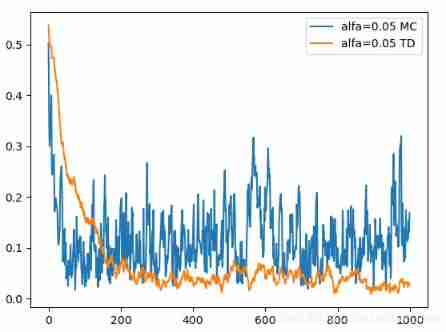


## settings
import math
import numpy as np
import random
# visualization
import matplotlib
import matplotlib.pyplot as plt
from matplotlib.ticker import MultipleLocator
# INVARIANT
# state
STATE_LEFT = 0;
A = 1 ;
B = 2;
C = 3;
D = 4;
E = 5;
STATE_RIGHT = 6;
STATE =[ A,B,C,D,E ]
TERMINAL_STATE = [STATE_LEFT,STATE_RIGHT];
# action
LEFT = -1;
RIGHT = 1;
ACTION = [LEFT,RIGHT];
# random policy
random_policy = np.zeros((7,2),dtype = np.float);
for state in STATE:
random_policy[state][LEFT] = 0.5;
random_policy[state][RIGHT] = 0.5;
# discount
gamma = 1;
ALFA =[0.05,0.1,0.2];
# loop number
LOOP_EPISODE = 1000;
targets = [1.0/6,2.0/6,3.0/6,4.0/6,5.0/6]
# get reward
def get_reward(next_state):
return 1 if next_state==STATE_RIGHT else 0;
# get action
def get_action(state,policy):
p=[];
for action in ACTION:
p.append(policy[state][action]) ;
return np.random.choice(ACTION,p=p)
# Agent class
class Agent_class():
def __init__(self):
self.state_set=[];
self.reward_set=[];
self.current_state = C;
self.state_set.append(C);
def finish_sampling(self,policy):
while self.current_state in STATE:
action = get_action( self.current_state,policy );
self.current_state += action;
self.state_set.append(self.current_state);
self.reward_set.append(get_reward(self.current_state));
def get_rms(predictions,targets):
return np.sqrt( ((predictions-targets)**2).mean() );
for alfa in ALFA:
V_MC = np.zeros(7,dtype = np.float);
V_TD = np.zeros(7,dtype = np.float);
MC_RSM=[];
TD_RSM=[];
for every_loop in range(0,LOOP_EPISODE):
agent = Agent_class();
agent.finish_sampling(random_policy);
for state in range(0,len(agent.state_set)-1):
current_state = agent.state_set[state];
next_state = agent.state_set[state+1];
V_TD[current_state] = (1-alfa)*V_TD[ current_state ] + \
alfa*( agent.reward_set[state] + gamma *V_TD[ next_state ]);
G_t = agent.reward_set[-1];
for i in range(1,len(agent.state_set)):
current_state = agent.state_set[-i-1];
next_state = agent.state_set[-i];
V_MC[current_state] = (1-alfa)*V_MC[current_state] + \
alfa*gamma*G_t;
MC_RSM.append( get_rms(V_MC[1:6],targets) );
TD_RSM.append( get_rms(V_TD[1:6],targets) );
plt.plot(MC_RSM,'-',label='alfa='+str(alfa)+' MC');
plt.plot(TD_RSM,'-',label='alfa='+str(alfa)+' TD');
plt.legend();
plt.show()
'''
plt.plot(V_MC[1:6],label='alfa='+str(alfa)+' MC')
plt.plot(V_TD[1:6],label='alfa='+str(alfa)+' TD')
plt.legend();
plt.show()
'''
On-policy TD Control (Sarsa)

After every updation of every state in an episode, we could update the policy quickly rather than after every total episode in Monte Carlo.
Windy Gridworld
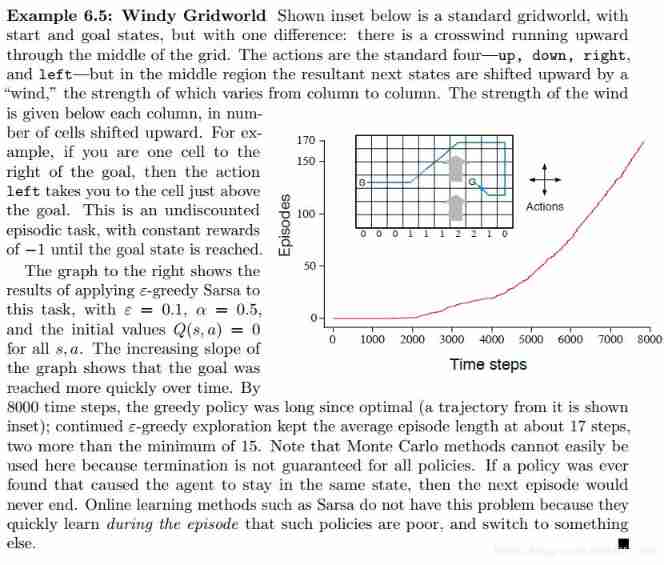 State: every position in this grid, the terminal state is the goal position.
State: every position in this grid, the terminal state is the goal position.
Action: left,right,up,down. there are some additional actions in the center of the gridworld.
reward: -1, until arrive at the terminal state.
policy evauluation: TD(0)
policy improvement: update after the iteration in every state
When soft-policy is applied (sigma=0.05,it's constant), we could get good result even optimal result sometimes.


When soft-policy is applied (sigma=0.05,it's decreasing from 0.05 to 0), we could get optimal result .
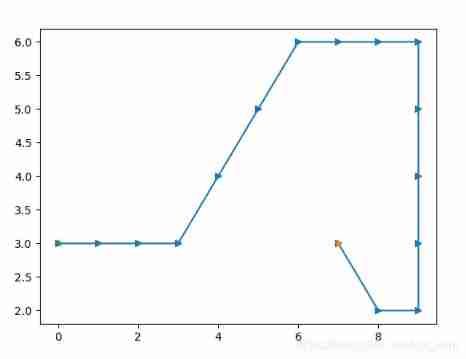

Code
## settings
import math
import numpy as np
import random
# visualization
import matplotlib
import matplotlib.pyplot as plt
from matplotlib.ticker import MultipleLocator
# list copy
import copy
# INVARIANTS
#state (x,y)
STATE_INITIAL = (0,3);
STATE_GOAL = (7,3)
WIDTH = 10;
HEIGHT = 7;
# action
LEFT = (-1,0);
RIGHT = (1,0);
UP = (0,1);
DOWN = (0,-1);
ACTION_INTENDED = [LEFT,RIGHT,UP,DOWN];
# policy pi(a|s) which start at random policy, and updated after every iteration (function)
policy_target={}; # policy[(x,y)][action]
dict_actions_policy={};
for action in ACTION_INTENDED:
dict_actions_policy[action]=1/len(ACTION_INTENDED);
for x in range(0,WIDTH):
for y in range(0,HEIGHT):
policy_target[(x,y)] = copy.deepcopy(dict_actions_policy)
# reward: q_s_a(STATE_GOAL)=0, reward in every step is -1.
R = -1;
# special part: windy_effect, which will change the action_intended into action_actual
# there are different influence on different x.
# 1 unit influence will produce additional up in gridworld.
ACTION_WIND_EFFECT = [0,0,0,1,1,1,2,2,1,0];
# parameters we set
# sigma-policy
SIGMA = 0.05;
# number of episode
LOOP_EPISODE = 200;
# discounting parameter
gamma = 1;
# iteration step
alfa = 0.5;
# FUNCTIONS
# FUNCTIONS in policy evaluation
def choose_action(state,policy):
p=[];
index=range(0,len(ACTION_INTENDED));
for action in ACTION_INTENDED:
p.append(policy[state][action]);
action_intended = ACTION_INTENDED[np.random.choice(index,p=p)];
return action_intended;
# actual action taken (update after choice of actions )
def get_actual_action(state,action_intended):
x = action_intended[0]
y = action_intended[1] + ACTION_WIND_EFFECT[ state[0] ];
return ( (x,y) );
# state after the actual action taken
# the agent could not get out of the grid world.
def get_state_next(state,action):
state_next = ( state[0]+action[0], state[1]+action[1] );
x = max(state_next[0],0);
x = min(x,WIDTH-1);
y = max(state_next[1],0);
y = min(y,HEIGHT-1);
return (x,y);
# FUNCTIONS in policy improvement
# update after every iteration and use sigma-policy
def policy_updation(state,Q_s_a,policy):
Q=[];
for action in ACTION_INTENDED:
Q.append(Q_s_a[state][action]);
action_max = ACTION_INTENDED[np.argmax(Q)];
for action in ACTION_INTENDED:
policy[state][action] = sigma/len(ACTION_INTENDED);
policy[state][action_max] += 1 - sigma;
# CLASS
# CLASS Agent
class Agent_class():
def __init__(self):
# q_s_a[state][action] initial value =0;
self.Q_s_a={};
self.policy = copy.deepcopy( policy_target );
dict_q_action={};
for action in ACTION_INTENDED:
dict_q_action[action] = 0;
for x in range(0,WIDTH):
for y in range(0,HEIGHT):
self.Q_s_a[(x,y)] = copy.deepcopy( dict_q_action );
self.action_total_set=[];
self.state_total_set=[];
# current state
self.current_state = STATE_INITIAL;
# current action
self.current_intended_action = choose_action(self.current_state,self.policy)
self.current_actual_action = get_actual_action(self.current_state,self.current_intended_action);
def finish_journey(self):
# current state
self.current_state = STATE_INITIAL;
# current action
self.current_intended_action = choose_action(self.current_state,self.policy)
self.current_actual_action = get_actual_action(self.current_state,self.current_intended_action);
# state set and action set
action_set=[];
state_set=[];
action_set.append( self.current_intended_action );
state_set.append( self.current_state );
next_state = get_state_next(self.current_state,self.current_actual_action);
while next_state != STATE_GOAL:
# get the next action;
next_action_intended = choose_action(next_state,self.policy);
next_action_actual = get_actual_action(next_state,next_action_intended)
# policy evaluation
self.Q_s_a[self.current_state][self.current_intended_action] = (1-alfa)*\
self.Q_s_a[self.current_state][self.current_intended_action] + alfa* \
(R + self.Q_s_a[next_state][next_action_intended]);
#policy improvement
policy_updation(self.current_state,self.Q_s_a,self.policy)
# update current state and action
self.current_intended_action = next_action_intended;
self.current_actual_action = next_action_actual;
self.current_state = next_state;
# append of state set and action set
action_set.append( self.current_intended_action );
state_set.append( self.current_state );
# get next state
next_state = get_state_next(self.current_state,self.current_actual_action);
# update when next state is terminal state
state_set.append(next_state)
self.Q_s_a[self.current_state][self.current_intended_action] = (1-alfa)*\
self.Q_s_a[self.current_state][self.current_intended_action] + alfa* R;
self.action_total_set.append(action_set);
self.state_total_set.append(state_set);
def show_step(self):
x=[];
y=[];
for state in self.state_total_set[-1]:
x.append(state[0]);
y.append(state[1]);
plt.plot(x,y,'->')
plt.plot(STATE_GOAL[0],STATE_GOAL[1],'*')
plt.plot(STATE_INITIAL[0],STATE_INITIAL[1],'*')
plt.show();
def show_step_number_of_every_episode(self):
number=[];
for i in range(0,len(self.action_total_set)):
number.append(len(self.action_total_set[i]));
plt.plot(number,'-*')
plt.xlabel('number of episodes')
plt.ylabel('number of steps')
plt.show();
# main programming
agent = Agent_class();
for every_loop in range(0,LOOP_EPISODE):
#sigma = SIGMA*(LOOP_EPISODE-every_loop)/LOOP_EPISODE;
sigma = SIGMA;
agent.finish_journey();
agent.show_step();
agent.show_step_number_of_every_episode();
Off-policy TD Control (Q-learning)

Result
When soft-policy is applied (sigma=0.05,constant), we could get good result . Because it will have some non-perfect actions.
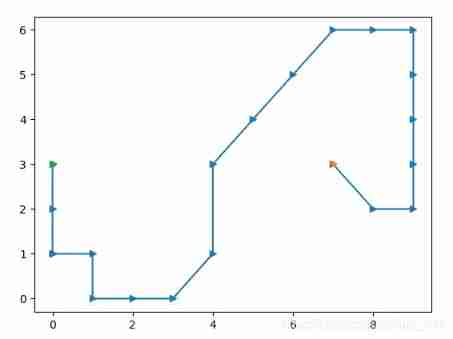
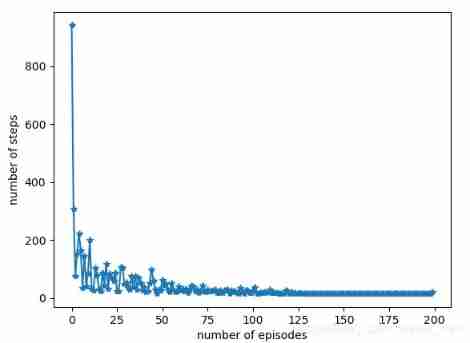
When soft-policy is applied (sigma=0.05,it's decreasing from 0.05 to 0), we could get optimal result . But more episodes are needed than Sarsa.




Code
## settings
import math
import numpy as np
import random
# visualization
import matplotlib
import matplotlib.pyplot as plt
from matplotlib.ticker import MultipleLocator
# list copy
import copy
# INVARIANTS
#state (x,y)
STATE_INITIAL = (0,3);
STATE_GOAL = (7,3)
WIDTH = 10;
HEIGHT = 7;
# action
LEFT = (-1,0);
RIGHT = (1,0);
UP = (0,1);
DOWN = (0,-1);
ACTION_INTENDED = [LEFT,RIGHT,UP,DOWN];
# policy pi(a|s) which start at random policy, and updated after every iteration (function)
policy_target={}; # policy[(x,y)][action]
dict_actions_policy={};
for action in ACTION_INTENDED:
dict_actions_policy[action]=1/len(ACTION_INTENDED);
for x in range(0,WIDTH):
for y in range(0,HEIGHT):
policy_target[(x,y)] = copy.deepcopy(dict_actions_policy)
# reward: q_s_a(STATE_GOAL)=0, reward in every step is -1.
R = -1;
# special part: windy_effect, which will change the action_intended into action_actual
# there are different influence on different x.
# 1 unit influence will produce additional up in gridworld.
ACTION_WIND_EFFECT = [0,0,0,1,1,1,2,2,1,0];
# parameters we set
# sigma-policy
SIGMA = 0.05;
# number of episode
LOOP_EPISODE = 100;
# discounting parameter
gamma = 1;
# iteration step
alfa = 0.5;
# FUNCTIONS
# FUNCTIONS in policy evaluation
def choose_action(state,policy):
p=[];
index=range(0,len(ACTION_INTENDED));
for action in ACTION_INTENDED:
p.append(policy[state][action]);
action_intended = ACTION_INTENDED[np.random.choice(index,p=p)];
return action_intended;
def choose_max_action(state,Q_s_a):
Q=[];
choice=[];
for action in ACTION_INTENDED:
Q.append(Q_s_a[state][action]);
for i in range(0,len(Q)):
if Q[i]==max(Q):
choice.append(ACTION_INTENDED[i]);
action_max = random.choice(choice);
return action_max;
# actual action taken (update after choice of actions )
def get_actual_action(state,action_intended):
x = action_intended[0]
y = action_intended[1] + ACTION_WIND_EFFECT[ state[0] ];
return ( (x,y) );
# state after the actual action taken
# the agent could not get out of the grid world.
def get_state_next(state,action):
state_next = ( state[0]+action[0], state[1]+action[1] );
x = max(state_next[0],0);
x = min(x,WIDTH-1);
y = max(state_next[1],0);
y = min(y,HEIGHT-1);
return (x,y);
# FUNCTIONS in policy improvement
# update after every iteration and use sigma-policy
def policy_updation(state,Q_s_a,policy):
Q=[];
for action in ACTION_INTENDED:
Q.append(Q_s_a[state][action]);
action_max = ACTION_INTENDED[np.argmax(Q)];
for action in ACTION_INTENDED:
policy[state][action] = sigma/len(ACTION_INTENDED);
policy[state][action_max] += 1 - sigma;
# CLASS
# CLASS Agent
class Agent_class():
def __init__(self):
# q_s_a[state][action] initial value =0;
self.Q_s_a={};
self.policy = copy.deepcopy( policy_target );
dict_q_action={};
for action in ACTION_INTENDED:
dict_q_action[action] = 0;
for x in range(0,WIDTH):
for y in range(0,HEIGHT):
self.Q_s_a[(x,y)] = copy.deepcopy( dict_q_action );
self.action_total_set=[];
self.state_total_set=[];
# current state
self.current_state = STATE_INITIAL;
# current action
self.current_intended_action = choose_action(self.current_state,self.policy)
self.current_actual_action = get_actual_action(self.current_state,self.current_intended_action);
def finish_journey(self):
# current state
self.current_state = STATE_INITIAL;
# current action
self.current_intended_action = choose_action(self.current_state,self.policy)
self.current_actual_action = get_actual_action(self.current_state,self.current_intended_action);
# state set and action set
action_set=[];
state_set=[];
action_set.append( self.current_intended_action );
state_set.append( self.current_state );
next_state = get_state_next(self.current_state,self.current_actual_action);
while next_state != STATE_GOAL:
# get the next action;
next_action_intended = choose_max_action(next_state,self.Q_s_a);
next_action_actual = get_actual_action(next_state,next_action_intended)
# policy evaluation
self.Q_s_a[self.current_state][self.current_intended_action] = (1-alfa)*\
self.Q_s_a[self.current_state][self.current_intended_action] + alfa* \
(R + self.Q_s_a[next_state][next_action_intended]);
#policy improvement
policy_updation(self.current_state,self.Q_s_a,self.policy)
# update current state and action
self.current_intended_action = next_action_intended;
self.current_actual_action = next_action_actual;
self.current_state = next_state;
# append of state set and action set
action_set.append( self.current_intended_action );
state_set.append( self.current_state );
# get next state
next_state = get_state_next(self.current_state,self.current_actual_action);
# update when next state is terminal state
state_set.append(next_state)
self.Q_s_a[self.current_state][self.current_intended_action] = (1-alfa)*\
self.Q_s_a[self.current_state][self.current_intended_action] + alfa* R;
self.action_total_set.append(action_set);
self.state_total_set.append(state_set);
def show_step(self):
x=[];
y=[];
for state in self.state_total_set[-1]:
x.append(state[0]);
y.append(state[1]);
plt.plot(x,y,'->')
plt.plot(STATE_GOAL[0],STATE_GOAL[1],'*')
plt.plot(STATE_INITIAL[0],STATE_INITIAL[1],'*')
plt.show();
def show_step_number_of_every_episode(self):
number=[];
for i in range(0,len(self.action_total_set)):
number.append(len(self.action_total_set[i]));
plt.plot(number,'-*')
plt.xlabel('number of episodes')
plt.ylabel('number of steps')
plt.show();
# main programming
agent = Agent_class();
for every_loop in range(0,LOOP_EPISODE):
sigma = SIGMA*(LOOP_EPISODE-every_loop)/LOOP_EPISODE;
#sigma = SIGMA;
agent.finish_journey();
agent.show_step();
agent.show_step_number_of_every_episode();
Expected Sarsa

If we select actions in soft-greedy policy and use this policy to update Q, then it will be on-policy expected Sarsa.
If we select actions in non-greedy policy and use greedy policy to update Q, then expected Sarsa will be Q-learning.
Result
when sigma = 0.1, the influence of differnent alfa in different algorithom:
Sarsa algorithon is not stable when alfa is large such as 0.9. But Q-learning and Expected Sarsa are stable.


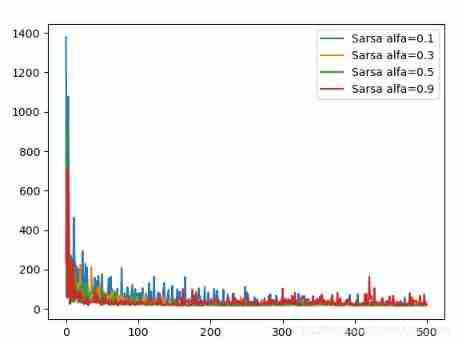
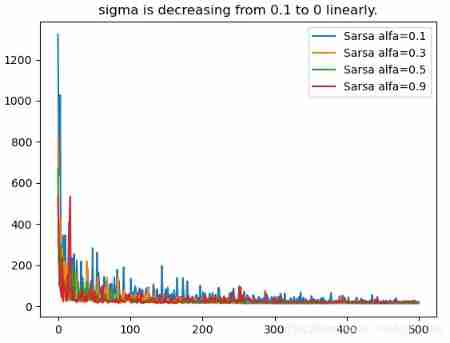
Code
## settings
import math
import numpy as np
import random
# visualization
import matplotlib
import matplotlib.pyplot as plt
from matplotlib.ticker import MultipleLocator
# list copy
import copy
# INVARIANTS
#state (x,y)
STATE_INITIAL = (0,3);
STATE_GOAL = (7,3)
WIDTH = 10;
HEIGHT = 7;
# action
LEFT = (-1,0);
RIGHT = (1,0);
UP = (0,1);
DOWN = (0,-1);
ACTION_INTENDED = [LEFT,RIGHT,UP,DOWN];
# policy pi(a|s) which start at random policy, and updated after every iteration (function)
policy_target={}; # policy[(x,y)][action]
dict_actions_policy={};
for action in ACTION_INTENDED:
dict_actions_policy[action]=1/len(ACTION_INTENDED);
for x in range(0,WIDTH):
for y in range(0,HEIGHT):
policy_target[(x,y)] = copy.deepcopy(dict_actions_policy)
# reward: q_s_a(STATE_GOAL)=0, reward in every step is -1.
R = -1;
# special part: windy_effect, which will change the action_intended into action_actual
# there are different influence on different x.
# 1 unit influence will produce additional up in gridworld.
ACTION_WIND_EFFECT = [0,0,0,1,1,1,2,2,1,0];
# parameters we set
# sigma-policy
SIGMA = 0.1;
# number of episode
LOOP_EPISODE = 500;
# discounting parameter
gamma = 1;
# iteration step
ALFA =[ 0.1,0.3,0.5,0.9];
# FUNCTIONS
# FUNCTIONS in policy evaluation
def choose_action(state,policy):
p=[];
index=range(0,len(ACTION_INTENDED));
for action in ACTION_INTENDED:
p.append(policy[state][action]);
action_intended = ACTION_INTENDED[np.random.choice(index,p=p)];
return action_intended;
def choose_max_action(state,Q_s_a):
Q=[];
choice=[];
for action in ACTION_INTENDED:
Q.append(Q_s_a[state][action]);
for i in range(0,len(Q)):
if Q[i]==max(Q):
choice.append(ACTION_INTENDED[i]);
action_max = random.choice(choice);
return action_max;
# actual action taken (update after choice of actions )
def get_actual_action(state,action_intended):
x = action_intended[0]
y = action_intended[1] + ACTION_WIND_EFFECT[ state[0] ];
return ( (x,y) );
# state after the actual action taken
# the agent could not get out of the grid world.
def get_state_next(state,action):
state_next = ( state[0]+action[0], state[1]+action[1] );
x = max(state_next[0],0);
x = min(x,WIDTH-1);
y = max(state_next[1],0);
y = min(y,HEIGHT-1);
return (x,y);
# FUNCTIONS in policy improvement
# update after every iteration and use sigma-policy
def policy_updation(state,Q_s_a,policy):
Q=[];
for action in ACTION_INTENDED:
Q.append(Q_s_a[state][action]);
actions_max = [];
for i in range(0,len(ACTION_INTENDED)):
if Q_s_a[state][ACTION_INTENDED[i]]==max(Q):
actions_max.append(ACTION_INTENDED[i]);
action_max = random.choice(actions_max);
for action in ACTION_INTENDED:
policy[state][action] = sigma/len(ACTION_INTENDED);
policy[state][action_max] += 1 - sigma;
# CLASS
# CLASS Agent
class Agent_class():
def __init__(self):
# q_s_a[state][action] initial value =0;
self.Q_s_a={};
self.policy = copy.deepcopy( policy_target );
dict_q_action={};
for action in ACTION_INTENDED:
dict_q_action[action] = 0;
for x in range(0,WIDTH):
for y in range(0,HEIGHT):
self.Q_s_a[(x,y)] = copy.deepcopy( dict_q_action );
self.action_total_set=[];
self.state_total_set=[];
self.step_number_in_episode={};
# current state
self.current_state = STATE_INITIAL;
# current action
self.current_intended_action = choose_action(self.current_state,self.policy)
self.current_actual_action = get_actual_action(self.current_state,self.current_intended_action);
def finish_journey(self):
# current state
self.current_state = STATE_INITIAL;
# current action
self.current_intended_action = choose_action(self.current_state,self.policy);
self.current_actual_action = get_actual_action(self.current_state,self.current_intended_action);
# state set and action set
action_set=[];
state_set=[];
action_set.append( self.current_intended_action );
state_set.append( self.current_state );
next_state = get_state_next(self.current_state,self.current_actual_action);
while next_state != STATE_GOAL:
# policy evaluation average of every action
Q_temp= (1-alfa)*self.Q_s_a[self.current_state][self.current_intended_action]\
+alfa*R;
for action in ACTION_INTENDED:
Q_temp+= alfa*self.Q_s_a[next_state][action]*self.policy[next_state][action];
self.Q_s_a[self.current_state][self.current_intended_action]=Q_temp;
#policy improvement
policy_updation(self.current_state,self.Q_s_a,self.policy)
# get the next action;
next_action_intended = choose_max_action(next_state,self.Q_s_a);
next_action_actual = get_actual_action(next_state,next_action_intended)
# update current state and action
self.current_intended_action = next_action_intended;
self.current_actual_action = next_action_actual;
self.current_state = next_state;
# append of state set and action set
action_set.append( self.current_intended_action );
state_set.append( self.current_state );
# get next state
next_state = get_state_next(self.current_state,self.current_actual_action);
# update when next state is terminal state
state_set.append(next_state)
self.Q_s_a[self.current_state][self.current_intended_action] = (1-alfa)*\
self.Q_s_a[self.current_state][self.current_intended_action] + alfa* R;
self.action_total_set.append(action_set);
self.state_total_set.append(state_set);
def show_step(self):
x=[];
y=[];
for state in self.state_total_set[-1]:
x.append(state[0]);
y.append(state[1]);
plt.plot(x,y,'->')
plt.plot(STATE_GOAL[0],STATE_GOAL[1],'*')
plt.plot(STATE_INITIAL[0],STATE_INITIAL[1],'*')
plt.show();
def step_number_of_every_episode(self):
number=[];
for i in range(0,len(self.action_total_set)):
number.append(len(self.action_total_set[i]));
self.step_number_in_episode=number;
def show_step_number_of_every_episode(self):
number=[];
for i in range(0,len(self.action_total_set)):
number.append(len(self.action_total_set[i]));
plt.plot(number,'-*')
plt.xlabel('number of episodes')
plt.ylabel('number of steps')
plt.show();
# main programming
number_set =[];
for alfa in ALFA:
agent = Agent_class();
for every_loop in range(0,LOOP_EPISODE):
#sigma = SIGMA*(LOOP_EPISODE-every_loop)/LOOP_EPISODE;
sigma = SIGMA;
agent.finish_journey();
#agent.show_step();
agent.step_number_of_every_episode();
number_set.append(agent.step_number_in_episode);
for i in range(0,len(ALFA)):
plt.plot(number_set[i],label='expected Sarsa '+'alfa='+str(ALFA[i]))
plt.legend();
plt.show();
边栏推荐
- There is no shortcut to learning and development, and there is almost no situation that you can learn faster by leading the way
- Simulate mouse click
- CV learning notes - feature extraction
- LeetCode - 673. 最长递增子序列的个数
- Vscode markdown export PDF error
- Of course, the most widely used 8-bit single chip microcomputer is also the single chip microcomputer that beginners are most easy to learn
- Openeuler kernel technology sharing - Issue 1 - kdump basic principle, use and case introduction
- CV learning notes - deep learning
- 3.2 Off-Policy Monte Carlo Methods & case study: Blackjack of off-Policy Evaluation
- 2021-10-27
猜你喜欢

Leetcode 300 longest ascending subsequence

CV learning notes - reasoning and training

Swing transformer details-1

SCM is now overwhelming, a wide variety, so that developers are overwhelmed
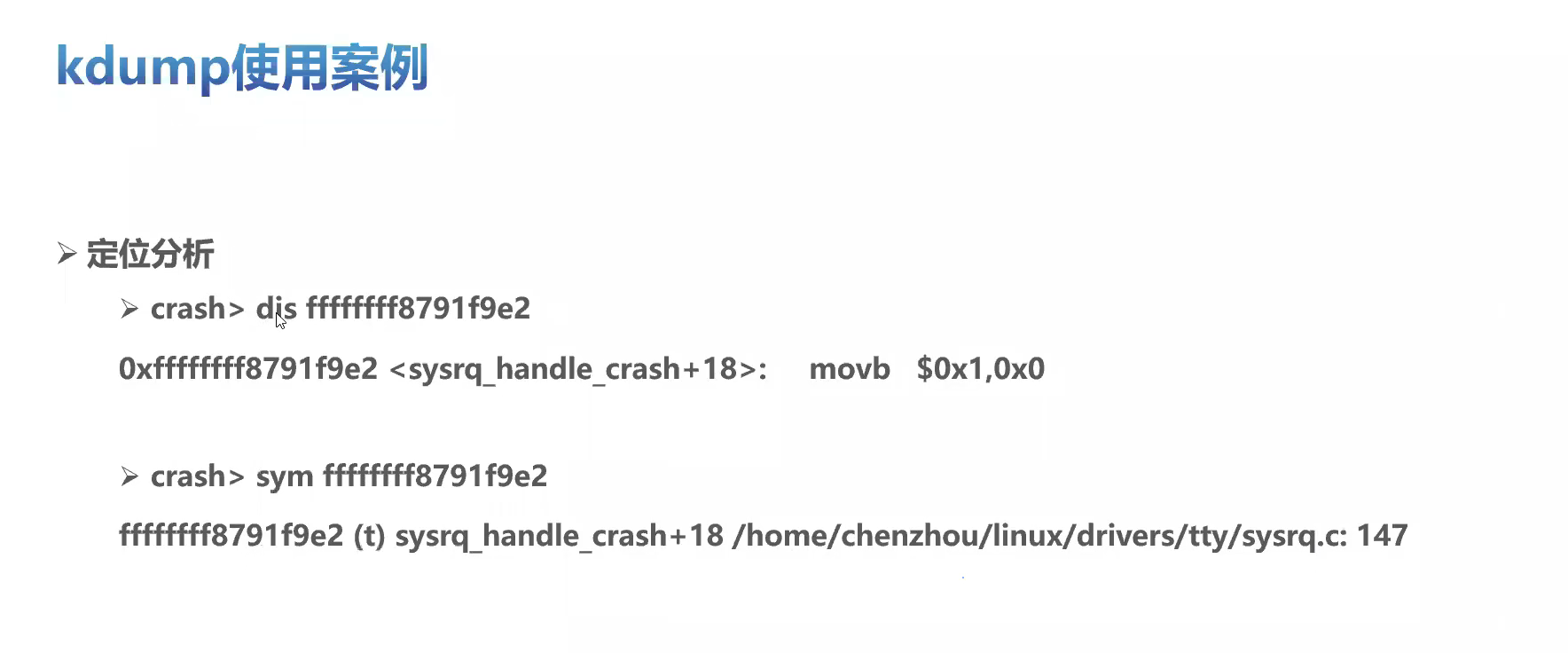
Openeuler kernel technology sharing - Issue 1 - kdump basic principle, use and case introduction

2021-10-28
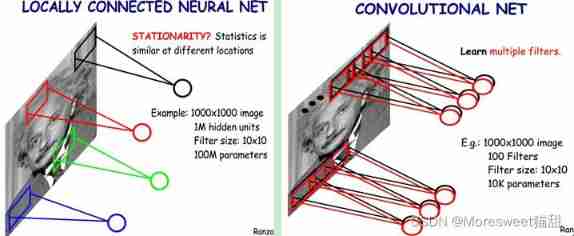
CV learning notes convolutional neural network
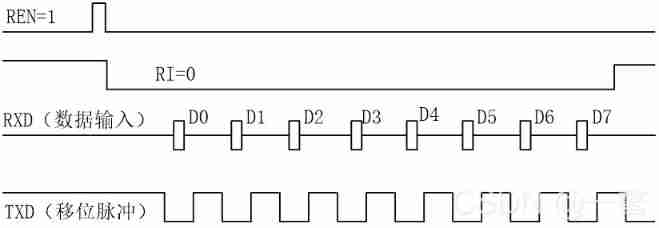
Working mode of 80C51 Serial Port

The new series of MCU also continues the two advantages of STM32 product family: low voltage and energy saving

yocto 技术分享第四期:自定义增加软件包支持
随机推荐
Leetcode bit operation
Leetcode - 1670 design front, middle and rear queues (Design - two double ended queues)
Opencv Harris corner detection
(1) What is a lambda expression
My 4G smart charging pile gateway design and development related articles
2.2 DP: Value Iteration & Gambler‘s Problem
getopt_ Typical use of long function
Yocto Technology Sharing Phase 4: Custom add package support
Pycharm cannot import custom package
Open Euler Kernel Technology Sharing - Issue 1 - kdump Basic Principles, use and Case Introduction
On the problem of reference assignment to reference
el-table X轴方向(横向)滚动条默认滑到右边
LeetCode - 703 数据流中的第 K 大元素(设计 - 优先队列)
CV learning notes - image filter
. DLL and Differences between lib files
I think all friends should know that the basic law of learning is: from easy to difficult
4G module board level control interface designed by charging pile
2021-10-28
2312. Selling wood blocks | things about the interviewer and crazy Zhang San (leetcode, with mind map + all solutions)
Windows下MySQL的安装和删除